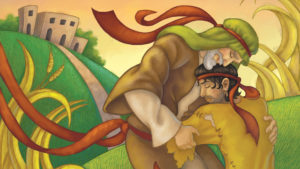Parables are some of the most engaging portions of Scripture and are ideal for use in the Sunday School classroom. Understanding Jesus’ purpose in teaching through parables takes us to John’s words in chapter twenty of his Gospel,”. . . but these are written so that you may believe that Jesus is the Christ, the Son of God, and that by believing you may have life in His name.” Jesus came to earth and took on human flesh to live a perfect life in the place of sinners and suffer innocently on the cross to pay the full price of our iniquities.
Through faith we receive the benefits of this work: forgiveness and eternal life in heaven. All of Jesus’ teaching ministry supported His work of redemption in that it highlighted what He would do for us on the cross. The parables are no exception. Underneath the main purpose of accentuating Jesus’ life, death, and resurrection stand three other related purposes: to glorify His Father in heaven, to present the nature of the Kingdom of God, and to instruct Christians how to live on earth.
Consider these examples of Jesus’ parables:
Jesus’ work of redemption
New Wine in Old Wine Skins: What Jesus brings to the sinner. (Mark 2:22)
The Parable of the Sower: The Holy Spirit brings faith to the unbeliever. (Matthew 13:3–9)
Glorifying the Father
Good Samaritan: God saves those who are His natural enemies. (Luke 10:25–37)
The Prodigal Son: God searches for the lost. (Luke 15:11–13)
Nature of the Kingdom of God
Lowest Seat at the Feast: We see the love of God in Jesus’ humility. (Luke 14: 7–11)
The Parable of the Wedding Feast: God would have us be righteous in Christ. (Matthew 22:1–14)
Christian life on earth
A Lamp Under a Basket: Sharing Christ with others. (Mark 4:21–25)
The Wise and the Foolish Builders: Understanding the cost of knowing Jesus. (Matthew 7:24–27)
Yeast: Recognizing false teaching. (Matthew 13:33)
Unmerciful Servant: Forgiving others as God forgave us in Christ. (Matthew 18:21–35)
When presenting Jesus’ parables, it’s important to keep the above goals in mind. In other words, as teachers in the Sunday School classroom, we ask ourselves, How does the parable highlight Jesus’ work to forgive our sins, elucidate the Kingdom of God, His nature, or instruct on Christian living? Am I bringing out the elements in the parable toward that end?
As Lutherans we are also mindful of the need to maintain a clear distinction between Law and Gospel when teaching the parables. Law: How does this parable show the need for salvation, turn me away from sinful behavior, or educate me on how to live for the Lord? Gospel: How does this parable emphasize what Jesus did for me in His perfect life, death and resurrection? How does it make clear the work of the Holy Spirit in creating and maintaining my saving faith?
For example, the parable of the Sower and the Soils compares the sinful heart to stony earth. The Good Samaritan teaches how those who would be most apt to show mercy often don’t. The Wedding Banquet reminds us the imminent return of Christ and the danger of straying from His salvation. The Unmerciful Servant admonishes us against withholding grace toward those who need our forgiveness. The Lowest Seat at the Feast directs our minds to the humility of Jesus Christ, who, having the glory of heaven, chose to embrace sin and death to give us forgiveness and life. The Unmerciful Servant shows us the grace of the God, in that He had no debts of His own, yet freely forgave His debtors in Christ. The Sower and the Soils teaches the work of the Holy Spirit in creating faith using the Gospel of Jesus Christ.
As always, although God does want us to live righteously, avoid the temptation to moralize with parables. In other words, shy away from such points as, Be more like the Good Samaritan. He loved everyone. If you disobey like the Prodigal Son, you’ll end up feeding pigs, too! If we keep our lamp under a bowl, people will go to hell. Instead, accentuate how Jesus embodied the behavior He expects. In doing so, He earned righteousness, forgiveness and life eternal for us. Ultimately, Jesus used the parables to communicate that we would have life in Him, not merely that we would improve our behavior.
Parables are often narrative in form. For this reason, they lend themselves to the visual, even the theatrical. For younger students, encourage them to draw pictures of the events in each parable. Have them draw a series of empty boxes on a sheet of paper. In these boxes, the students draw a series of simple pictures that convey the events in the parables. Encourage them to add speech and thought bubbles. Invite students to present their drawings during the lesson. For older students, have them dramatize the events in the parable. Some students will be able to do this by improvisation while another student reads; others will prefer to write out a more formal set of scenes and acts. Be sure to follow up with a summary of the parable’s meaning at the end.
You can also use songs to make learning about parables even more memorable. All God’s People Sing [1] has a number of great options, including A Stable Lamp is Lighted (Lamp Under a Bowl), Go Tell It on the Mountain (Sower and the Soil), Let Us Ever Walk with Jesus (the Prodigal Son), Make Me a Servant (Lowest Seat at the Feast), Soon and Very Soon (The Wedding Banquet), and Thy Word is a Lamp (Lamp Under a Bowl).
God’s richest blessings to you as you present our Lord’s parables to His sheep!
